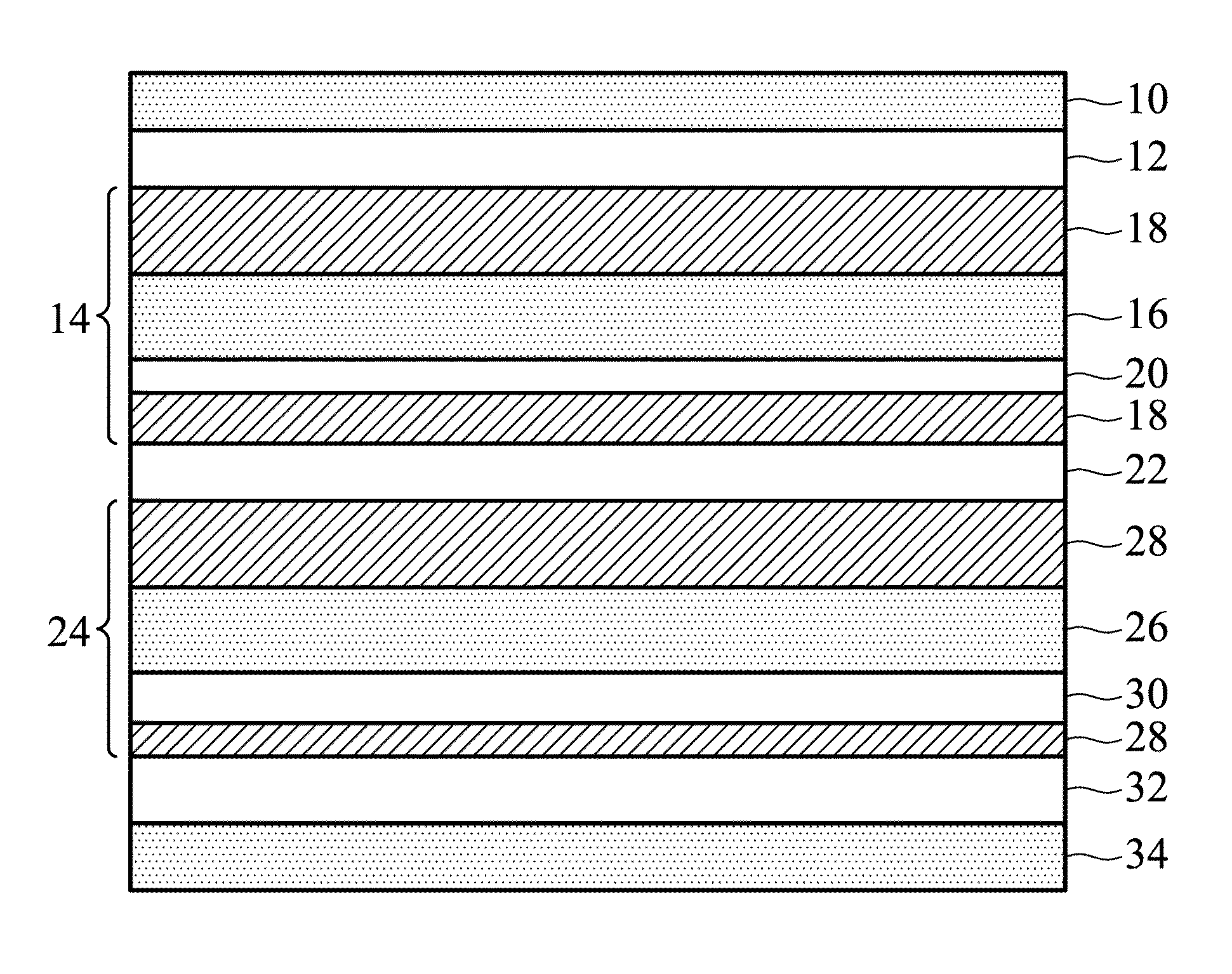Gas-barrier heat-seal composite films and vacuum insulation panels comprising the same
a technology of which is applied in the field of gas-barrier heat-seal composite films and vacuum insulation panels, can solve the problems of not coming close to meeting gas barrier requirements, unable to be applied easily, and not allowing gas to pass thereto, etc., to achieve high gas barrier, improve metal adhesion and gas barrier effects, and improve the effect of gas barrier
- Summary
- Abstract
- Description
- Claims
- Application Information
AI Technical Summary
Benefits of technology
Problems solved by technology
Method used
Image
Examples
example 1
Preparation of the Gas-Barrier Heat-Seal Composite Film (1)
[0028]A multiple-layered composite film was prepared by the evaporation and binding method, as shown in FIG. 1. The composite film comprised, from top to bottom, a PET protective layer 10 (with a thickness of 13 μm), an epoxy resin glue 12 (with a thickness of 7 μm), a PET composite layer 14 (a PET substrate 16 with a thickness of 17 μm vacuum-metallized with two aluminum layers 18 with a respective thickness of 30 nm on both sides thereof, and a primer layer 20 with a thickness of 7 μm), an epoxy resin glue 22 (with a thickness of 7 μm), a PET composite layer 24 (a PET substrate 26 with a thickness of 17 μm plated with two aluminum layers 28 with a respective thickness of 30 nm on both sides thereof, and a primer layer 30 with a thickness of 7 μm), an epoxy resin glue 32 (with a thickness of 7 μm) and a PE heat-seal layer 34 (with a thickness of 60 μm). In this example, the oxygen transmission rate of the gas-barrier heat-s...
example 2
Preparation of the Gas-Barrier Heat-Seal Composite Film (2)
[0029]A multiple-layered composite film was prepared by the evaporation and binding method, as shown in FIG. 2. The composite film comprised, from top to bottom, a PET composite layer 36 (a PET substrate 38 with a thickness of 17 μm vacuum-metallized with two aluminum layers 40 with a respective thickness of 30 nm on one side thereof toward an epoxy resin glue 44, and a primer layer 42 with a thickness of 7 μm), the epoxy resin glue 44 (with a thickness of 7 μm), a PET composite layer 46 (a PET substrate 48 with a thickness of 17 μm vacuum-metallized with two aluminum layers 50 with a respective thickness of 30 nm on one side thereof toward an epoxy resin glue 44, and a primer layer 52 with a thickness of 7 μm), an epoxy resin glue 54 (with a thickness of 7 μm) and a EP-copolymer heat-seal layer 56 (with a thickness of 60 μm). In this example, the oxygen transmission rate of the gas-barrier heat-seal composite film was lower...
example 3
Preparation of the Gas-Barrier Heat-Seal Composite Film (3)
[0030]A multiple-layered composite film was prepared by the evaporation and binding method, as shown in FIG. 3. The composite film comprised, from top to bottom, a PET protective layer 58 (with a thickness of 13 μm), an epoxy resin glue 60 (with a thickness of 7 μm), a PET composite layer 62 (a PET substrate 64 with a thickness of 17 μm vacuum-metallized with two aluminum layers 66 with a respective thickness of 30 nm on both sides thereof, and a primer layer 68 with a thickness of 7 μm), an epoxy resin glue 70 (with a thickness of 7 μm), a EVOH composite layer 72 (a EVOH substrate 74 containing 44% ethylene with a thickness of 20 μm metallized with one aluminum layer 76 with a thickness of 30 nm on one side thereof toward the epoxy resin glue 70 bound with the metallized aluminum layer 76), an epoxy resin glue 78 (with a thickness of 7 μm) and a PE heat-seal layer 80 (with a thickness of 60 μm). In this example, the oxygen ...
PUM
| Property | Measurement | Unit |
|---|---|---|
| thickness | aaaaa | aaaaa |
| thickness | aaaaa | aaaaa |
| thickness | aaaaa | aaaaa |
Abstract
Description
Claims
Application Information
 Login to View More
Login to View More - R&D
- Intellectual Property
- Life Sciences
- Materials
- Tech Scout
- Unparalleled Data Quality
- Higher Quality Content
- 60% Fewer Hallucinations
Browse by: Latest US Patents, China's latest patents, Technical Efficacy Thesaurus, Application Domain, Technology Topic, Popular Technical Reports.
© 2025 PatSnap. All rights reserved.Legal|Privacy policy|Modern Slavery Act Transparency Statement|Sitemap|About US| Contact US: help@patsnap.com



